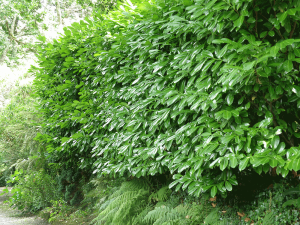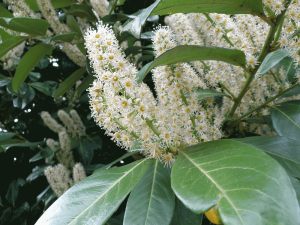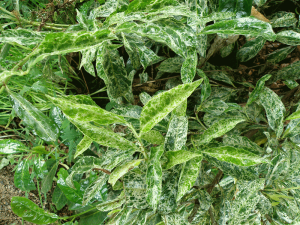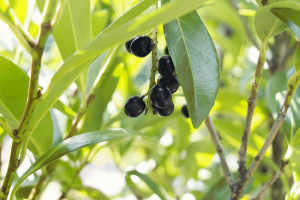The cherry laurel is one of the most widely planted screening plants in gardens having reached western Europe by the end of the 16th century and is recorded in cultivation in Britain in the 17th century. It has been cultivated that extensively its geographical origins seem to be a little hazy but would appear to stretch from the east coast of the Adriatic sea eastwards along the south coast of the Black seas as far as the Caspian sea.
It is hard now to appreciate the effect that this plants arrival would have had in western gardens at the time of its arrival. Gardens at the time would have had very few evergreen bushes and along comes this large vigorous bush with its mass of large smooth shiny evergreen leaves. Added to this is the masses of white flower spikes in late spring and the small black fruits in autumn. Few plants offer such a range of attractive features. Sadly now it has been relegated to being a plant of little garden value.
This is in part because we have so many more plants to choose from now but also it has been a victim of its own success. It has been over planted in the past because of its appeal as a fast growing evergreen leading it to being used where a fast evergreen hedge is wanted’ a role it isn’t really suited to. Its large leaves look tatty and unattractive when it is cut with shears or a hedge cutter and it should really be cut back with secateurs. If you must have an inappropriately fast growing hedge you are better with × Cupressocyparis leylandii. On the rare occasions it is allowed to grow unmolested it makes a fine large flowering shrub in a large garden. Unfortunately it most often ends up crammed into far too small a space with its hacked leaves blacked at the cut edges. I have seen examples of people trying to grow it as a 600 mm high by 300mm wide hedge, something such a large and large leaved plant will never do successfully and which there are far more appropriate plants for.
In most cases the form Prunus laurocerasus ‘Rotundifolia’ is grown in place of Prunus laurocerasus having leaves half as broad as long and a yellower green than the species. Other cultivars of note are Prunus laurocerasus ‘Castlewellan’ (syn. P. ‘Marble White’) a less vigorous plant with white marbled leaves, Prunus laurocerasus ‘Otto Luyken’ )a low shrub with upward pointing leaves and stems and Prunus laurocerasus ‘Zabeliana’ a low horizontally branching shrub which makes excellent ground cover even under the dripping shade of trees.
Along the way it acquired a variety of names until Linneaus set it as Prunus laurocerasus L. in the 1753 in the first volume of Species Plantarum. Prunus is the Latin for a plum tree which is in the genus and laurocerasus comes from laurel, the Latin for laurel, and cerasus, the Latin for cherry. This and the common name reflect the small round black fruits which resemble cherries. These cherry like fruits or their common name of cherry laurel should not lead you to believe the plant is in any way edible. All of the plant is poisonous and the reason you do not hear of people being poisoned by it is because you will be very ill before you have chance to eat sufficient to poison yourself. These poisonous chemicals are also the ones which produce the almond smell from the crushed leaves. That said this has not stopped people from trying to use it as a quack medicine. Laurel water was used for various treatments but is basically a solution of hydrogen cyanide of varying concentration and so extremely dangerous.







